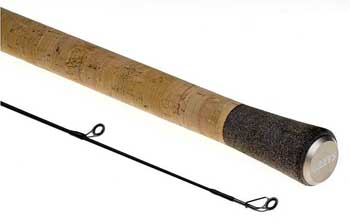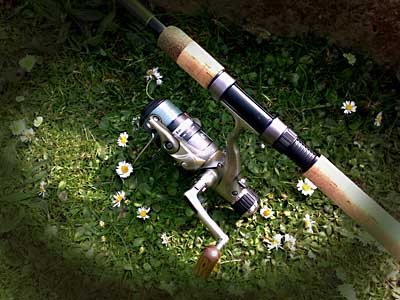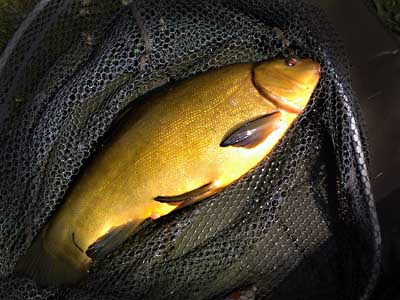The manufacturer says –
When the discerning angler wants a slightly shorter light specimen rod, Greys discovered the majority of current designs had rather pokey actions and surprisingly heavy test curves.
In order to fill this gap in the market, Greys developed the Prodigy TX 11ft Specimen, a 1lb test curve rod, which offers a much more forgiving action. This is coupled with a lightweight nature and top quality components at a very competitive price!
This delightful rod can be applied to a wealth of applications, including stalking big fish in the margins, free lining, float fishing, legering, feeder fishing, spinning and light carp tactics…the list is endless! It’s also perfect for confined swims, travelling light, roving and a host of other situations.
The forgiving through action allows tackle to be scaled down when fish are proving tricky to tempt, while the high modulus carbon blank and braid friendly SIC line guides can equally cope with presenting stepped up lines and larger hooks. There’s plenty of crisp casting and hook setting power, combined with a lovely anti-lock action when the streamlined blank is put under pressure.
A secure screw lock reel seat, quality cork handle, hinged hook keeper ring, laser etched butt cap and subtle matt grey finish complete a superb package.
 High modulus carbon.
High modulus carbon.- Forgiving 1lb test curve.
- Subdued matt grey finish.
- Full SIC line guides.
- Secure screw lock reel seat.
- Quality cork handle.
- Folding hook keeper ring/laser etched butt cap.
- Worldwide Extended Warranty.
Model Code Length (ft) Sections Weight (oz / g) Price (£)
Prodigy TX Specimen 1.0lb GPTXSM010 11 2 260G – 7.30oz 89.99
The reviewer says –
First things first, what a great looking rod. An 11 foot, slender and light weight, matt black blank finished off with quality Fuji SIC line guides, understated graphics and full cork handle; I always appreciate a full cork handle, it feels nicer and just looks better than any of the modern alternatives. In case you don’t know, cos I didn’t until I Googled it, SIC line guides disperse heat better than other materials keeping friction damage to a minimum.
 The Prodigy TX Specimen is sold as having a 1.0lb test curve, but most of that initial 90° bend occurs in and near the tip. As the pressure exceeds that first pound, however, the rest of the blank continues to follow smoothly and with increasing power all the way down to the butt. The result is a rod that is capable of coping with a broad range of angling situations and styles. The 1.0lb test curve tag is one that really only gives an idea of the sensitivity in the top section of this rod. Greys claim that it is capable of handling main lines rated from 4 – 12lb and hook lengths of 3 – 10lb, and I have no reason to doubt that statement.
The Prodigy TX Specimen is sold as having a 1.0lb test curve, but most of that initial 90° bend occurs in and near the tip. As the pressure exceeds that first pound, however, the rest of the blank continues to follow smoothly and with increasing power all the way down to the butt. The result is a rod that is capable of coping with a broad range of angling situations and styles. The 1.0lb test curve tag is one that really only gives an idea of the sensitivity in the top section of this rod. Greys claim that it is capable of handling main lines rated from 4 – 12lb and hook lengths of 3 – 10lb, and I have no reason to doubt that statement.
I took it out for a day’s tenching at a local lake, one I have only just discovered and was raring to try out; especially as local knowledge tells me that there is a chance of a double figure fish.
I began by using the rod for waggler fishing at around 3-4 rod lengths out. As the lake has an almost uniform depth of around 5ft moving swims was fairly easy and little or no adjustment to my set up was necessary. Casting my 2 Swan shot waggler was easy with the rod punching it into the wind with relative ease, and bear in mind that I hold no awards of note for my float casting skills. Well, no awards at all if I’m honest.
On the odd occasion that I thought I spotted a bite, and struck at it, the rod picked up the line well and made swift contact with the float, however, as the day wore on, the wind picked up and made keeping an eye on the float tip increasingly difficult.
Initially I cursed my lack of foresight in leaving my second rod, with it’s quiver tip sections, in the car but I had to try something different or I knew I would be going home fish-less. With waggler fishing as my objective for the day I had limited alternative tackle with me, but I threaded two drilled bullets onto the 5lb line between two float stops about half a foot apart and created a light, semi running, leger rig. I fished the main line straight through to the hook, which was a size 14 with a small pellet banded to the shank, and hooked a mini PVA bag of similar sized freebies on before casting out over my already well ground baited swim. I kept the rod at right angles to the line leaving the top ring and fished it as if it were a quiver. The weight of just the two drilled bullets was enough to put a slight curve in the tip and the bites were easy to spot.
 My cobbled together set-up, combined with the delicate nature of the top section, was perfect for the conditions and within an hour had brought a new PB tench to my landing net. The 5lb 10oz fish was never in danger of stretching the rod anywhere near it’s limit, but the smooth action ensured it retained all the pleasure you get from playing a good sized fish on well balanced tackle.
My cobbled together set-up, combined with the delicate nature of the top section, was perfect for the conditions and within an hour had brought a new PB tench to my landing net. The 5lb 10oz fish was never in danger of stretching the rod anywhere near it’s limit, but the smooth action ensured it retained all the pleasure you get from playing a good sized fish on well balanced tackle.
I now have another reason to wish away the rest of the close season: so that I can do some roving river fishing with this rod. Free-lining baits for chub and trotting a small dead-bait or big lob worm under a chubber float for perch would both suit this rod down to the ground.
In my admittedly limited experience of rods over the few years I’ve been fishing I can honestly say that this is probably the most versatile rod I have used.
Paul Howarth













